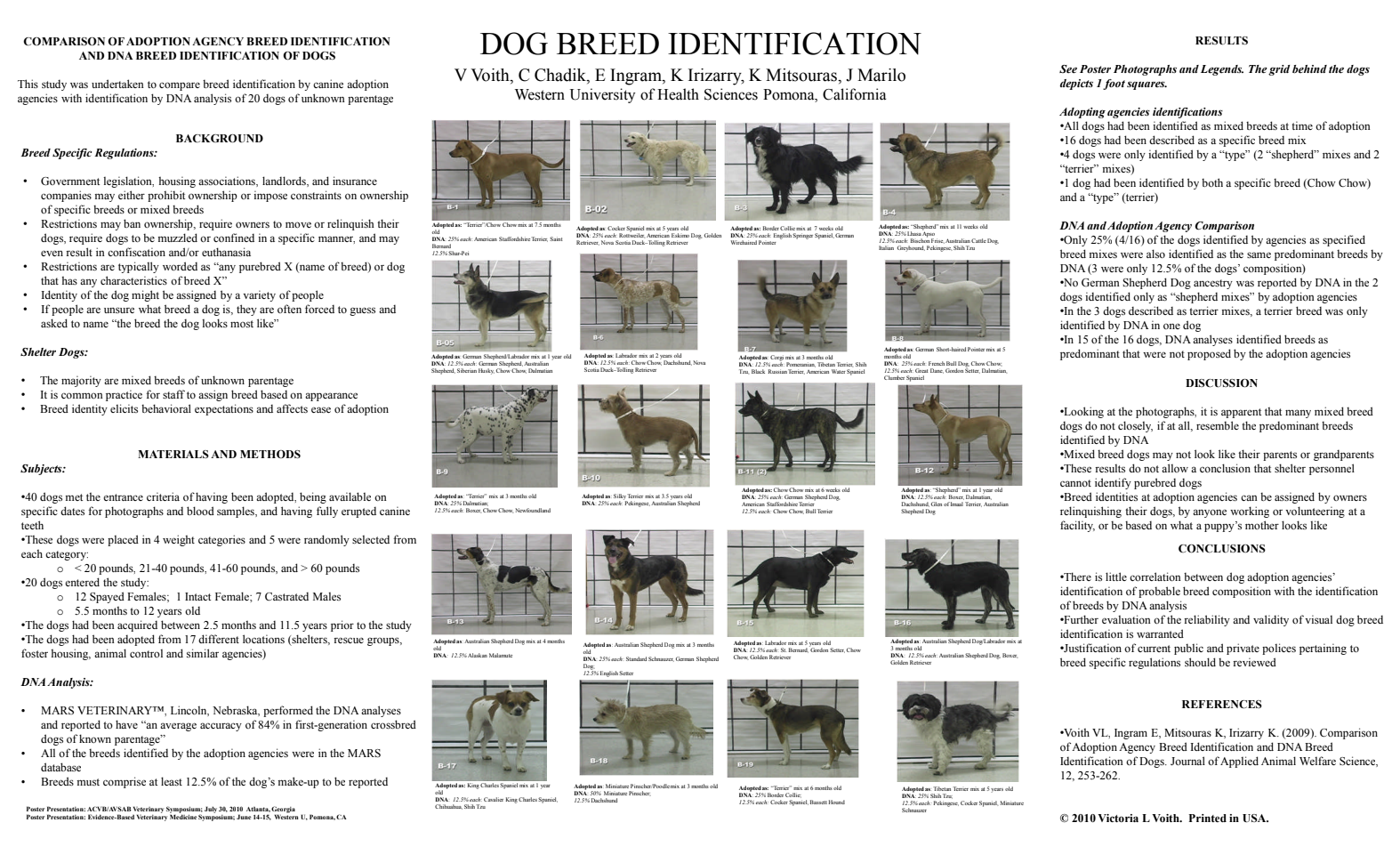To best understand this article in the context of the visual breed identification literature, please see National Canine Research Council’s complete analysis here.
National Canine Research Council Summary and Analysis:
This study compared adoption agencies’ visual breed identifications of 20 mixed-breed dogs against DNA analysis.
The researchers used dogs adopted from shelters and rescues because they commonly label their dogs by breed for adopters. Owners (students, staff, and faculty at the College of Veterinary Medicine at Western University of Health Sciences) volunteered 50 dogs for the study, of which twenty from 17 different agencies were ultimately included. All dogs were adopted from a shelter, rescue, animal control, or similar agency. Owners completed surveys detailing the dogs’ demographic information including weight, age, sex, size, source of the dog, and how the breed had been identified by the source. Researchers verified the weight and five dogs were randomly selected from each of four weight categories (<20 lb, 21–40 lb, 41–60 lb, and >60 lb) for a total of twenty subjects. Blood samples were taken and sent to MARS VETERINARYTM laboratory to be analyzed using The Mars Veterinary Wisdom Panel MXTM. DNA analysis was conducted and breed was determined using a statistical model that infers breed from a pattern of 300 genetic markers.
All dogs were determined to be mixed breed by their adopting agencies and 80% were assigned at least one predominant breed. Four dogs were assigned a type rather than breed, and one was assigned both a type and a breed. DNA testing reported all breeds that contributed at least 12.5% of a dog’s makeup. Breeds were classified as either predominant or less dominant based on their representation in the DNA analysis, such that the breed(s) with the highest reported percentage was labeled as predominant.
The results showed little agreement between reported breed (from visual identification) and actual breed as determined by DNA analysis. Of the 16 dogs that had been assigned a specific breed as predominant by their adopting agency, DNA analysis showed that only 4 were actually predominantly comprised of said breed. Furthermore, for 3 of the 4 that did have genetic markers matching their visually identified breed, that breed contributed at most 12.5% of their makeup. Finally, those 3 dogs also had other breeds of equal contribution that were not identified by their adopting agencies. One additional dog showed a less dominant breed that matched its visual identification. In all only 31% of the dogs showed any DNA evidence of the adoption agencies’ named breeds anywhere in the dogs’ ancestry. Over 90% of the dogs identified by agencies as having one or two specific breeds in their ancestry did not have their visually identified breeds as the predominant breed in their DNA analysis.
There is a potential sampling bias in this study that should be considered. It is plausible that participants who disagreed with the breed assigned to their dog were more likely to volunteer their dogs for DNA testing. Additional studies with larger random samples could be conducted to rule out this possibility. However, more recent studies by Gunter, Barber, & Wynne (2018), Voith et al. (2013), and Olson et al. (2015) do corroborate the present findings, so this weakness is unlikely to have affected the data.
The data are compelling evidence that visual breed identification is unreliable. There are additional troubling implications of these results, particularly in the realm of canine research and policy. Many studies have been conducted linking breed to behavior, and many of these studies have relied on visual breed identification as the basis for analysis. Such studies are then used to justify public and private policies regarding whether and how dogs so identified may be kept. Thus, researchers and public policy makers should very carefully examine studies that link breed and behavior; if breed was reported without DNA confirmation or pedigree, the data cannot be considered reliable.






